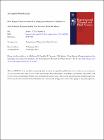Validation of numerical methods in cold spray by direct nozzle-internal measurements of non-dilute particle motion

File Type:
PDFItem Type:
ThesisDate:
2018Author:
Access:
openAccessCitation:
MEYER, MORTEN-CHRISTIAN LOUIS, Validation of numerical methods in cold spray by direct nozzle-internal measurements of non-dilute particle motion, Trinity College Dublin.School of Engineering.MECHANICAL AND MANUFACTURING ENGINEERING, 2018Download Item:
Abstract:
This work presents the research conducted during the development of a new optical particle velocity measurement in the field of Cold Spray. Cold Spray is a process for surface coating formation and additive manufacturing, in which powder particles are accelerated by an expanding process gas in a converging-diverging supersonic nozzle and deposited via high-speed impact onto a substrate. Temperatures below the melting point are characteristic for this process, which leads to unique benefits, such as low oxide contents and residual stresses, as well as sprayability of progressive material combinations and temperature-sensitive powders. The core feature of this process is the gas-particle nozzle and jet flow, defining the required high velocities upon impact. Although some aspects can be simulated reasonably well using computational models, the general validity of such is case-dependent and coverage of advanced features, such as the particle loading effect, is not yet established. As a result, application challenges like nozzle clogging and the prediction of the deposition efficiency cannot be assessed with these methods. In order to overcome this limitation and to provide means for validation of a new generation of computational models, a new measurement technique is developed in this study.
The approach combines the Cold Spray process with a Particle Tracking Velocimetry system and introduces the design of a transparent quartz glass nozzle for internal particle motion measurements. Particle behaviour during powder injection, nozzle-immanent distribution, acceleration as well as particle dispersion within the jet were observed at various pressures and particle loadings. The injector position was varied to study the influence of the particle injection plume and materials were altered to identify differences between distinct Stokes number ranges. The character of the particle phase motion was analysed and particle-particle interactions found to play an important role. Firstly, acceleration of particles in the nozzle were experimentally quantified and the statistical distributions for particle speed and direction evaluated, highlighting the importance of randomised motion. This information was used to advance the understanding of nozzle clogging and particle heating residence time.
Commercially available software (Ansys FLUENTv16.0) was used to construct a computational model with advanced methods, including full phase coupling, particle collisions and a tailored particle phase boundary condition. The value of the presented experimental set-up for advanced model validation was demonstrated by comparing the measurements against the simulation results. Limits of such computational models were identified in this respect: it is necessary to employ an advanced, fully coupled model to obtain adequate velocity predictions, while dispersion characteristics remain challenging also for detailed models. This results in very material-dependent opportunities for computational clogging and heating time analysis. The validation was used to identify ways to manipulate the models for better representation of the nozzle-internal flow physics.
Sponsor
Grant Number
Marie Curie
Author's Homepage:
http://people.tcd.ie/meyermDescription:
APPROVED
Author: MEYER, MORTEN-CHRISTIAN LOUIS
Advisor:
Lupoi, RoccoPublisher:
Trinity College Dublin. School of Engineering. Discipline of Mechanical & Manuf. EngType of material:
ThesisCollections:
Availability:
Full text availableLicences:
Related items
Showing items related by title, author, creator and subject.
-
Flow regime characterisation of an impinging axisymmetric synthetic jet
MURRAY, DARINA; PERSOONS, TIM (2013)Impinging synthetic jets have excellent potential for energy-efficient local cooling in confined geometries. For a given geometry, synthetic jet flows are mainly characterised by the Reynolds number and the ratio of stroke ... -
Thermal fluctuations of magnetic nanoparticles: fifty years after Brown
COFFEY, WILLIAM (2012)The reversal time, superparamagnetic relaxation time, of the magnetization of fine single domain ferromagnetic nanoparticles owing to thermal fluctuations plays a fundamental role in information storage, paleomagnetism, ... -
Particle speed analysis in CoBlast
LUPOI, ROCCO (2015)The deposition of well-adhered thin type of coatings is of great importance in manufacturing and is used in numerous applications. Of particular interest in the biomedical sector is the deposition of hydroxyapatite onto ...







